Is hydrogen a viable option for powered access?
27 December 2022
Hydrogen is increasingly seen as a viable power source that can be used independently or in conjunction with electric equipment.
There are always challenges but the industry, it seems, is now at a turning point that will be taken.
Net zero construction sites
Speaking at the Europlatform conference in Rome, during September, James Cadman head of consultancy & carbon at Action Sustainability, shared some goals, explaining there is a stated aim of 78% reduction of diesel use across all the UK’s Contruction Leadership Council (CLC) sites by 2035.
For example, the UK’s National Highways want all sites to use zero-carbon plant by 2030 and the HS2 high speed rail project wants all sites diesel-free by 2029.
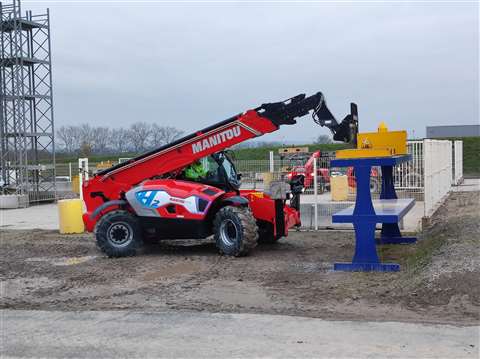 Manitou’s first hydrogen-powered telehandler prototype was unveiled at the beginning of December (2022). It is one of two prototypes being developed by the company to explore different hydrogen technologies. (Photo: Manitou)
Manitou’s first hydrogen-powered telehandler prototype was unveiled at the beginning of December (2022). It is one of two prototypes being developed by the company to explore different hydrogen technologies. (Photo: Manitou)
So, how do we get there? Electric power is the much-touted option and a realistic one at the moment.
Manitou is already on the 100% electric route with its MEWPs and telehandlers, and is promising to introduce a hydrogen-powered telehandler prototype by the end of this year as part of its ongoing major hydrogen project.
As Laurent Bonnaure, the executive VP of Manitou Group, says, the supply of hydrogen to jobsites is the major sticking point at present, but that is set to change.
Hydrogen fuel cells
To bring about the French telehandler’s vision, says Bonnaure, “We took an electric machine and instead of having a battery feeding the electric drive line, we use a fuel cell.
“One of the issues is how do we get a supply of hydrogen to the jobsite - that’s why we now have our hydrogen load station.”
The company is also looking at a more traditional concept of using hydrogen power in the same way an internal combustion engine would be used, for example in the form of a range extender – diesel versions of which are found on many electric MEWPs today.
“The beauty is that because our machines are going electric, the source that you use to power the electricity is a fuel cell, rather than a range extender, which uses fossil fuels to create electricity.”
Of course, the current industry approach to zero emissions is electricity generation, which Bonnaure concedes is the case but points out that the electric engine feeds far more easily into a hydrogen future than a traditional combustion engine alternative.
“Going back to internal combustion, hydrogen could be the answer and at prototype stage we are looking at these two solutions.
“The other advantage of electric is that the efficiency is very high. An electric driveline is very effective.
“However, the second step will be hydrogen – the issue is the cost of the fuel cell, which is very expensive, however the cost is reducing and when the volume is there for fuel cells that will be the way we go.”
Complete decarbonization
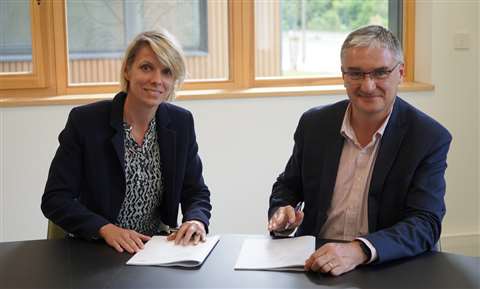 Caroline Mazzoleni, head of Smart Energy Division, Bouygues Energies & Services; and Patrice Metairie, COO, Haulotte Group.
Caroline Mazzoleni, head of Smart Energy Division, Bouygues Energies & Services; and Patrice Metairie, COO, Haulotte Group.
Haulotte is of the view that hydrogen is worth exploring for MEWPs and in June announced a collaboration with Bouygues Energies & Services to focus on using hydrogen energy to fuel its lift products.
Under the initiative between the two companies, engineering and services specialist Bouygues will test a Haulotte MEWP equipped with a hydrogen fuel cell system under real conditions on several of its construction sites over one year.
Bouygues will also study the hydrogen supply ecosystem for the entire construction sites on which the MEWP will be operating.
Haulotte says, “This partnership between the two groups aims to confirm the technical feasibility of using hydrogen technology in the construction sector to provide a low-carbon, zero-emission solution in response to climate, environmental and public health issues.”
In addition, Haulotte is exploring solutions for the complete decarbonization of its future aerial platform equipment.
“Haulotte and Bouygues Energies & Services project teams are delighted with this collaboration, which heralds an essential partnership between the players in the value chain, manufacturers, energy suppliers, customers and users, to deploy the first hydrogen projects,” adds Haulotte.
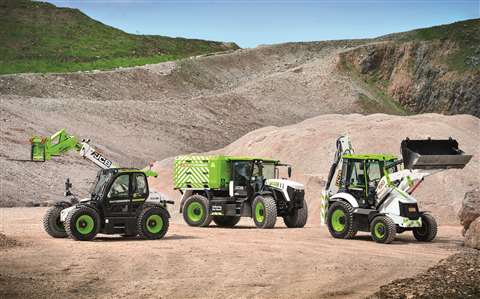 The new hydrogen refueller between JCB’s hydrogen powered telehandler and backhoe loader. (Photo: JCB)
The new hydrogen refueller between JCB’s hydrogen powered telehandler and backhoe loader. (Photo: JCB)
Mobile hydrogen refuelling
To answer the onsite supply question, JCB has unveiled a mobile hydrogen refueller which it says will allow o refuelling of hydrogen powered machines in the same way that fuel bowsers are used for diesel powered equipment.
The UK manufacturer said the refueller was part of its £100 million investment in hydrogen engines, which has so far created working prototypes of a backhoe loader and Loadall telescopic handler.
The mobile hydrogen refueller aims to provide an easy way for customers to refuel machines, the vast majority of which have fuel delivered to them while working on site, said the company. JCB said customers are already used to a transportable fuel.
The OEM has 100 engineers working on the hydrogen project. Its first hydrogen powered machine was a backhoe loader followed a year ago by a telescopic handler.
A hydrogen future is less certain for MEWPs, particularly the smaller varieties. Nevertheless, once the technology reduces in cost and is safe enough to use widely, the potential is certainly there.
Hydrogen is already a reality in some quarters. The world’s largest rental company United Rentals is adding a range of hydrogen zero emissions EODev generators to its North American rental fleet.
The company confirmed it expects to deploy the generators during the fourth quarter of 2022 and in 2023.
Hydrogen generators
United said that by adding hydrogen generators in the coming months, it will be able to offer customers “a zero-emissions power solution to charge electric vehicles and tools, and other equipment, advancing worksite electrification strategies.”
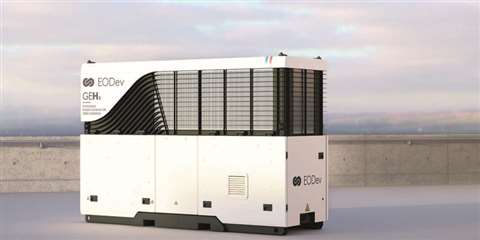 United is adding hydrogen powered zero emissions EODev generators from Generac.
United is adding hydrogen powered zero emissions EODev generators from Generac.
“The EODev GEH2 fuel cell electro-hydrogen generators bring companies the energy they need, without emissions of carbon dioxide (CO2), hydrocarbons (HC), nitrogen oxides (NOx) or other particulate matter (PM).”
They have a compact footprint of about 4 feet (1.2 m) by 11 feet (3.4 m), and deliver instant power up to 110 kVA (88 kW).
“They are equipped with the latest hydrogen fuel cells, and provide exceptional durability and reliability. In addition to the sustainability benefits, they also run much quieter than traditional generators,” United said.
The generators join units including emissions-free aerial lifts, trucks, vans, compact excavators, e-dumpsters and battery systems in the United Rentals portfolio of environmentally-friendly rental equipment.
Integrated energy systems
Back to the Europlatform conference in Rome, and Douglas McLuckie, managing director of ESG at Ashtead Group, talked about changing fuel sources, such as hydrogen – “that infrastructure is coming”, he said, as part of creating integrated energy solutions.
“We were at the forefront of battery technology from the very beginning, but not because of environmental concerns, rather because we needed machines that could work indoors,” he said.
“People like us to be able to report on the benefits we can have through battery technology.”
He talked about embodied carbon, thinking about everything “from cradle to grave” in the lifecycle of rental assets.
How renting access equipment lowers carbon emissions
By renting a typical asset to around 20 different clients per year effectively saves the embodied carbon of any given asset when compared to if that client had gone out and bought the machine rather than hired it.
Barrie Lindsay, director of engineering at JLG, gave an overview of how the manufacturer is trying to help meet global net zero targets, recently recommitted to by many nations at the COP26 summit in Glasgow, UK.
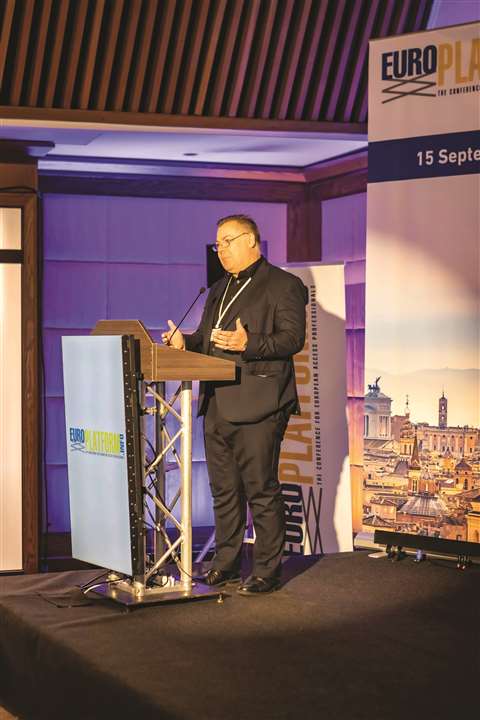 Barrie Lindsay, director of engineering at JLG.
Barrie Lindsay, director of engineering at JLG.
Reducing embodied carbon
“There has been a long-standing strategy to drive towards zero emissions. Interestingly, the pressure is not just from legislation, but from customers measuring and improving their own carbon emissions.
“Almost 70% of the carbon footprint can be attributed to steel and cast-iron components. So reducing the weight of these in each machine can significantly reduce carbon footprint. As a business, reducing carbon footprint is becoming mission critical.”
Charging infrastructure for electric equipment
He touched on the challenges of electrification across the portfolio of JLG’s products and looked at the implications and limitations of the current charging infrastructure.
“For a construction site, the charging points pose more of a challenge than for automotive applications. Equipment needs to be working during the day and charging overnight.
“New charging solutions are aiming at replacing diesel generators, so the ideas need to be scalable, and batteries need to have sufficient capacity to charge multiple machines.
“We have seen solar panel technology, but these are unlikely to be sufficient as larger battery technology develops. Charging points need to be standardised, including connector designs. Manufacturers need to combine efforts to overcome the charging infrastructure hurdle.”
The issue still, of course, applies to hydrogen and how to supply it on worksites. The debate rolls on but the industry appears to be a few significant steps closer.







